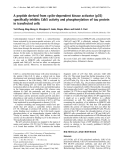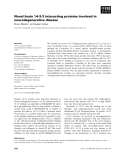
Neurodegenerative
-
Regulator of G-protein signaling (RGS) proteins were originally identified as negative regulators of G-protein-coupled receptor (GPCR) signaling via their GTPase-accelerating protein (GAP) activity. All RGS proteins contain evolutionarily conserved RGS domain; however, they differ in their size and regulatory domains. RGS1 and RGS10 are smaller than other RGS proteins, and their functions involve various inflammatory responses including autoimmune responses in both the periphery and the central nervous system (CNS). Neuroinflammation is the chronic inflammatory response in the CNS.
 5p
5p  caothientrangnguyen
caothientrangnguyen
 09-05-2020
09-05-2020
 28
28
 2
2
 Download
Download
-
The casein milk proteins and the brain proteinsa-synuclein and tau have been described as natively unfolded with ran-domcoil structures,which, inthecaseofa-synucleinandtau, have a propensity to form the ®brils found in a number of neurodegenerative diseases. New insight into the structures of these proteins has been provided by a Raman optical activity study, supplemented with dierential scanning cal-orimetry, of bovineb-andj-casein, recombinant humana-, b-andc-synuclein,
 9p
9p  research12
research12
 29-04-2013
29-04-2013
 41
41
 4
4
 Download
Download
-
Cyclin-dependent kinase-5 (Cdk5) is a serine/threonine kinase activated by its neuron-specific activator, p35, or its truncated form, p25. It has been proposed that the deregu-lation of Cdk5 activity by association with p25 in human brain tissue disrupts the neuronal cytoskeleton and may be involved in neurodegenerative diseases such as Alzheimer’s disease.
 8p
8p  research12
research12
 23-04-2013
23-04-2013
 32
32
 2
2
 Download
Download
-
Asheat shockproteins (Hsps) are involved inprotecting cells and also in the pathophysiology of diseases such as inflam-mation, cancer and neurodegenerative disorders, modula-tors ofHsp expression inmammalian cells would seemto be useful for the treatment of various diseases. In this study, we isolated mammalian cell lines for screening of Hsp modu-lators; mouse C3H10T1/2 cells stably transfected with a plasmid containing the mouse Hsp105 or human Hsp70B promoter upstream of a luciferase or b-galactosidase reporter gene, respectively....
 8p
8p  tumor12
tumor12
 20-04-2013
20-04-2013
 30
30
 5
5
 Download
Download
-
Methylglyoxal is the most important intracellular glycation agent, formed nonenzymatically from triose phosphates during glycolysis in eukaryotic cells. Methylglyoxal-derived advanced glycation end-products are involved in neurodegenerative disorders (Alzheimer’s, Parkinson’s and familial amy-loidotic polyneurophathy) and in the clinical complications of diabetes.
 11p
11p  fptmusic
fptmusic
 12-04-2013
12-04-2013
 43
43
 2
2
 Download
Download
-
We isolated two novel 14-3-3 binding proteins using 14-3-3fas bait in a yeast two-hybrid screen of a human brain cDNA library. One of these encoded the C-terminus of a neural specific armadillo-repeat protein, d-catenin (neural plakophilin-related arm-repeat protein or neurojungin). d-Catenin from brain lysates was retained on a 14-3-3 affinity column.
 9p
9p  fptmusic
fptmusic
 11-04-2013
11-04-2013
 22
22
 1
1
 Download
Download
-
Misfolded proteins, aggregates, and inclusion bodies are hall-marks of the cytopathology of neurodegenerative disorders including Huntington’s disease, Amyotropic lateral sclerosis, Parkinson’s disease, Prion diseases, and Alzheimer’s disease. The appearance of proteins with altered folded states is regula-ted by the protein folding quality control machinery and age-dependent. We have identified an unexpected molecular link between metabolic state, accumulation of damaged proteins, the heat-shock response and chaperones, and longevity....
 61p
61p  fptmusic
fptmusic
 11-04-2013
11-04-2013
 44
44
 5
5
 Download
Download
-
Protein aggregation is central to most neurodegenerative diseases, as shown by familial case studies and by animal models. A modified ‘amyloid cas-cade’ hypothesis for Alzheimer’s disease states that prefibrillar oligomers, also called amyloid-b-derived diffusible ligands or globular oligomers, are the responsible toxic agent. It has been proposed that these oligomeric spe-cies, as shown for amyloid-b, b2 -microglobulin or prion fragments, exert toxicity by forming pores in membranes, initiating a cascade of detrimental events for the cell. ...
 10p
10p  awards
awards
 06-04-2013
06-04-2013
 40
40
 3
3
 Download
Download
-
Neurodegenerative disorders, such as Huntington’s, Alzheimer’s, and Parkinson’s diseases, affect millions of people worldwide and currently there are few effective treatments and no cures for these diseases. Transgenic mice expressing human transgenes for huntingtin, amyloid precursor protein, and other genes associated with familial forms of neurodegenerative disease in humans provide remarkable tools for studying neurodegeneration because they mimic many of the pathological and behavioural features of the human conditions. ...
 15p
15p  awards
awards
 06-04-2013
06-04-2013
 39
39
 4
4
 Download
Download
-
Spinocerebellar ataxia types 2 (SCA2) and 3 (SCA3) are autosomal-dominantly inherited, neurodegenerative dis-eases caused by CAG repeat expansions in the coding regions of the genes encoding ataxin-2 and ataxin-3, respectively. To provide a rationale for further functional experiments, we explored the proteinarchitectures of ataxin-2 and ataxin-3. Using structure-based multiple sequence alignments of homologous proteins, we investigated domains, sequence motifs, and interaction partners.
 16p
16p  awards
awards
 05-04-2013
05-04-2013
 49
49
 5
5
 Download
Download
-
The extracellular signal regulated protein kinases (ERK1/2) are essential for normal development and functional plasti-city of the central nervous system. However, a growing number of recent studies in models of cerebral ischemia, brain trauma and neurodegenerative diseases implicate a detrimental role for ERK1/2 signaling during oxidative neuronal injury. Neurons undergoing oxidative stress-rela-ted injuries typically display a biphasic or sustained pattern of ERK1/2 activation.
 7p
7p  dell39
dell39
 03-04-2013
03-04-2013
 40
40
 3
3
 Download
Download
-
The interplay among reactive oxygen species (ROS) formation, elevated intracellular calcium concentration and mitochondrial demise is a recurring theme in research focusing on brain pathology, both for acute and chronic neurodegenerative states. However, causality, extent of contribution or the sequence of these events prior to cell death is not yet firmly established.
 18p
18p  dell39
dell39
 27-03-2013
27-03-2013
 41
41
 3
3
 Download
Download
-
Several studies have shown that deficient uptake or excessive break down of membrane phospholipids may be associated with neurodegenerative and psychiatric disorders. The purpose of the present study was to examine the effects of postnatal iron administration in lipid composition and behavior and whether or not the established effects may be altered by subchronic administration of the neuroleptic compounds, clozapine and haloperidol.
 12p
12p  inspiron33
inspiron33
 26-03-2013
26-03-2013
 50
50
 4
4
 Download
Download
-
A large number of neurodegenerative diseases in humans result from pro-tein misfolding and aggregation. Protein misfolding is believed to be the primary cause of Alzheimer’s disease, Parkinson’s disease, Huntington’s disease, Creutzfeldt–Jakob disease, cystic fibrosis, Gaucher’s disease and many other degenerative and neurodegenerative disorders.
 19p
19p  inspiron33
inspiron33
 26-03-2013
26-03-2013
 68
68
 5
5
 Download
Download
-
Neurodegenerative disorders are associated with oxidative stress. Low den-sity lipoprotein (LDL) exists in the brain and is especially sensitive to oxi-dative damage. Oxidative modification of LDL has been implicated in the pathogenesis of neurodegenerative diseases. Therefore, protecting LDL from oxidation may be essential in the brain.
 10p
10p  inspiron33
inspiron33
 26-03-2013
26-03-2013
 42
42
 4
4
 Download
Download
-
Huntington’s disease (HD) is a progressive neurodegenerative disorder characterized by multifarious dysfunctional alterations including mitochon-drial impairment. In the present study, the formation of inclusions caused by the mutation of huntingtin protein and its relationship with changes in energy metabolism and with pathological alterations were investigated both in transgenic and 3-nitropropionic acid-treated mouse models for HD.
 16p
16p  inspiron33
inspiron33
 23-03-2013
23-03-2013
 38
38
 6
6
 Download
Download
-
Protein glycation by methylglyoxal is a nonenzymatic post-translational modification whereby arginine and lysine side chains form a chemically heterogeneous group of advanced glycation end-products. Methylglyoxal-derived advanced glycation end-products are involved in pathologies such as diabetes and neurodegenerative diseases of the amyloid type.
 15p
15p  inspiron33
inspiron33
 23-03-2013
23-03-2013
 51
51
 4
4
 Download
Download
-
Caspase-3 is a programmed cell death protease involved in neuronal apop-tosis during physiological development and under pathological conditions. It is a promising therapeutic target for treatment of neurodegenerative dis-eases. We reported previously that isoquinoline-1,3,4-trione and its deriva-tives inhibit caspase-3.
 11p
11p  inspiron33
inspiron33
 23-03-2013
23-03-2013
 49
49
 4
4
 Download
Download
-
Prion diseases are fatal neurodegenerative disorders caused by proteina-ceous infectious pathogens termed prions (PrP Sc ). To date, there is no pro-phylaxis or therapy available for these transmissible encephalopathies. Passive immunization with monclonal antibodies recognizing the normal host-encoded prion protein (PrP C ) has been reported to abolish PrP Sc infec-tivity and to delay onset of disease.
 12p
12p  galaxyss3
galaxyss3
 21-03-2013
21-03-2013
 37
37
 3
3
 Download
Download
-
Prion diseases are neurodegenerative disorders which cause Creutzfeldt– Jakob disease in humans, scrapie in sheep and bovine spongiform encephalopathy in cattle. The infectious agent is a protease resistant iso-form (PrP Sc ) of a host encoded prion protein (PrP C ). PrP Sc proteins are characterized according to size and glycoform pattern.
 11p
11p  galaxyss3
galaxyss3
 21-03-2013
21-03-2013
 47
47
 4
4
 Download
Download
CHỦ ĐỀ BẠN MUỐN TÌM

































